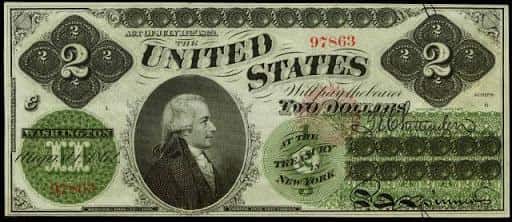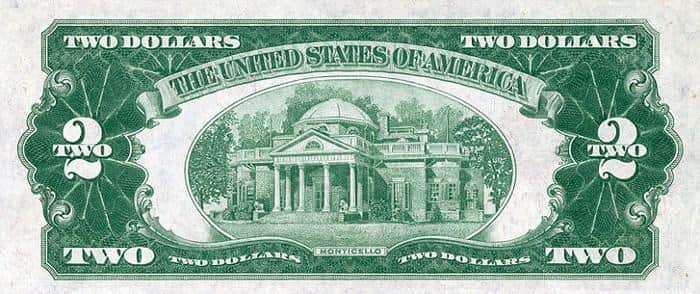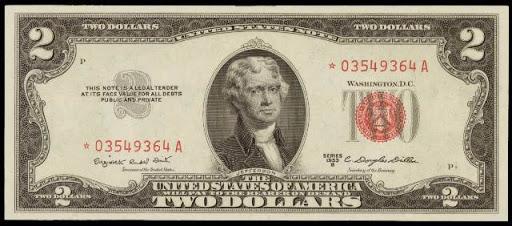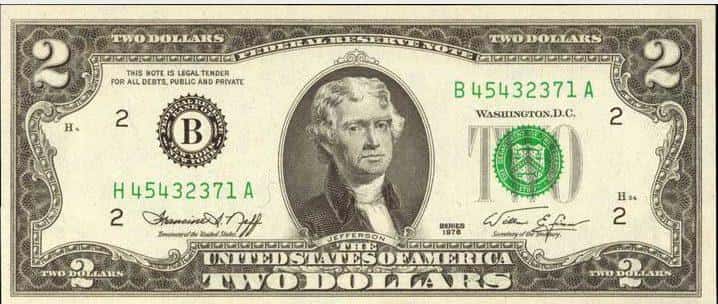Collecting $2 Bills from 1862 to Now
Posted by Andrew Adamo on Nov 13th 2024
Collecting $2 Bills from 1862 to Now
The $2 bill is widely considered the black sheep of U.S. paper currency that has never been very widely accepted by the American public, nor as widely collected as other denominations.
As the old (but obviously incorrect) saying goes, something is said “to be fake as a $2 bill.” In fact, many people, especially those of younger generations, think hey are fake when they see them because they have never encountered $2 bills, or hold on to them because they seem unusual and might be valuable.
When the Continental Congress was considering the first federally issued money, it initially authorized bills of credit in many denominations, including $2, but only 49,000 $2 notes were authorized. The problem is that that paper currency (not only $2 bills) was backed only by the word of the Congress and rapidly depreciated in value. This led them to forbid paper currency as legal tender and the issuance of only silver, copper and gold coinage after the U.S. Mint began operations in 1792.
Series 1862 $2 Bills
But during the Civil War with the federal Treasury department on the verge of bankruptcy, Treasury Secretary Salmon Chase, an abolitionist, proposed issuing legal tender notes to aid the Union’s financial situation. Those first $2 notes from 1862, which measured 7 and 3/8 th of an inch by 3 and 1/8th featured an engraving of Alexander Hamilton on the faceplate and ornate scrolls with “2” on the backplate.
But it took some time for paper currency to catch on because of the widespread preference for hard currency, and banks at the time issued their own paper bills too. Those large bills did not circulate very widely at the time partly because the average person earned less than a dollar a day, but then inflation eroded the value of the dollar, which increased their usage.
Series 1928 $2 Bills
Other large-size deuces, as $2 bills are known, were also issued, and starting with Series 1874 Hamilton was replaced by Thomas Jefferson, who is still on the bills today that are for this reason also known as “Toms”.
In 1928 the size was reduced to 6.14 inches by 2.6 inches, and starting with Series 1928 the backplate featured Monticello, Jefferson’s home. Until 1965 $2 notes always carried a red seal, and since then they have had a green seal. In addition, there are scarce blue seal $2 bills from the series 1918, which are worth from $350 in worn condition to thousands in uncirculated state.
By the time of the Great Depression when money was scarce, $2 bills began to be associated with superstition and also with bribes and other criminal activity. They were used by Tammany Hall (the 19 th century Democratic Party political machine in New York City that helped socialize new immigrants) to bribe immigrants for votes as well as in gambling and prostitution (at the time $2 was a popular increment for such activities).
This reputation certainly did not help for the circulation of the bills, which were actually very cost efficient for the government since it could make half as many of them as $2 bills and since they lasted much longer (about 6 years as opposed to 18 months for $1 bills) because people were more likely to hoard than spend them and use them for tips or as gifts.
By the early 1960s the $2 bill rarely circulated, and in 1966 it was officially discontinued because of low public demand. Overall, from its inception in 1862 until the 1965 bills were printed, a total of 1.6 billion were printed.
Series 1953 $2 Bill
This series saw the red seals on earlier $2 bills moved from the right side to the left side of the bills. Some Series 1953 $2 bills are scarce such as 1953-C * bills since only 360,000 were made and uncirculated examples are worth about $100.
If a $2 bill has a star next to its serial number, that means it is a Star Replacement Note, which are scarce and even circulated ones are worth from $5 to $50.
These notes have been printed since 1910 to replace misprinted or otherwise faulty notes, and the use of the star and a unique serial number is to help the government keep track of how many bills are out there. The number of star notes is much smaller than regular notes, which is why they are very collectible.
Series 1976 $2 Bills
In 1969 then director of the Bureau of Printing and Engraving James Conlon suggested reissuing the bills as a cost saving device. In 1970 a commission studying how to commemorate the upcoming Bicentennial of the United States in 1976 with coins and medals proposed issuing a $2 bill with a special design for the event.
In 1974 congressional legislation was introduced to print $2 Federal Reserve notes with a design emblematic of the bicentennial of the American Revolution on the reverse, and one chose by the Treasury Secretary on the obverse. The Federal Reserve commissioned a study that founded that while there was no latent demand for the $2 bill, if they were issued in large quantities, the public would use them.
On April 13, 1976, Jefferson’s 233 rd birthday, the reissuance of the $2 was effective and featured an obverse with a portrait of Jefferson based on a painting by Gilbert Stuart, and a reverse with a scene from the signing of the Declaration of Independence based on an 1818 painting by John Trumball.
Jefferson remains the only person to appear on both sides of U.S. paper currency.
How much are $2 bills worth?
$2 notes from Series 1976, 1995, 2003, 2003A, 2009 and 2013 still circulate. In circulated condition they are only worth their face value, while in nice uncirculated condition are worth $5-10.
The Series 1928 notes command $60 circulated and $100 uncirculated, while Series 1953 are worth $10 and $25 respectively, and Series 1963 about the same as 1953 notes.
A collection of each of those types of notes is not hard to obtain except for the star notes.
The larger size bills issued prior to 1928 are very collectible and even if very worn are worth $100. Uncirculated examples command from $500 to tens of thousands and should be professionally evaluated and graded by a service such as those offered by PMG, which is affiliated with NGC.
Collecting $2 bills can be a rewarding experience since many of them were printed in much smaller numbers than other paper currency and because of the unique role this denomination has had in American history.
OTHER ARTICLES YOU MAY LIKE:
1943 Steel Penny Value: How Much Steel Penny Coins Are Worth Now?
Statehood Quarters: U.S. Mint State Quarters Program and the Delaware Quarter
The Morgan Dollar Coins Values and History
Susan B. Anthony Dollar Coin Values and Prices
Rare Quarters Worth Money List
Learn more about: 1909 vdb penny value, 2023 silver eagle value, 1955 wheat penny value, 1953 d wheat penny value, 1957 wheat penny value, 1946 half dollars, 1956 penny value.






